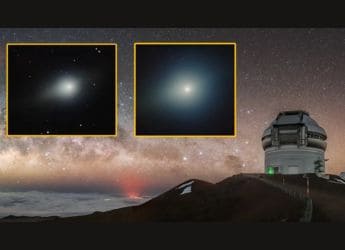- Home
- Science
- Science News
- MIT Researchers May Have Detected Rare ‘Black Widow’ System 3,000 Light Years From Earth
MIT Researchers May Have Detected Rare ‘Black Widow’ System 3,000 Light-Years From Earth
Astronomers have been able to detect only about two dozen black widow systems in the Milky Way.

Photo Credit: NASA's Goddard Space Flight Center/Cruz deWilde
A black widow star thrives by slowly consuming its smaller companion star.
The universe is full of enigma and mysteries. Millions of objects move around undetected. In fact, there's no dearth of such objects lurking in our very own Milky Way galaxy. We know very little of them, yet they continue to impact our lives in a number of ways. While the effort to study these objects continues, astronomers have detected a new object, roughly 3,000-4,000 light-years away, giving out mysterious flashes of light. They suspect that this object could be the elusive “black widow” star, a rapidly spinning pulsar, or neutron star, that thrives by slowly consuming its smaller companion star.
Black widow stars are rare since astronomers have been able to detect only about two dozen of them in the Milky Way. But researchers from the Massachusetts Institute of Technology (MIT), who found this enigmatic object, believe this could be the weirdest and most bizarre black widow pulsars of them all. They have named the newest candidate ZTF J1406+1222.
The researchers said the new candidate has the shortest orbital period yet identified, with the pulsar and companion star circling each other every 62 minutes. The system is unique because it appears to host a third star that orbits around the two inner stars every 10,000 years, they added in a statement on MIT's website.
This three-star system is raising questions about how it would have formed. The MIT researchers have attempted a theory for its origin: they feel the system likely arose from a dense constellation of old stars known as a globular cluster. This particular system may have drifted away from the cluster towards the centre of the Milky Way.
“This system has probably been floating around in the Milky Way for longer than the sun has been around,” said lead researcher and physicist Kevin Burdge from MIT's Department of Physics.
Their study has been published in the journal Nature. It details how the researchers used a new approach to detect this triple-star system. Most black widow binaries are detected through gamma and X-ray radiation emitted by the central pulsar, but MIT researchers use visible light to detect this system.
Get your daily dose of tech news, reviews, and insights, in under 80 characters on Gadgets 360 Turbo. Connect with fellow tech lovers on our Forum. Follow us on X, Facebook, WhatsApp, Threads and Google News for instant updates. Catch all the action on our YouTube channel.
Related Stories
- Samsung Galaxy Unpacked 2025
- ChatGPT
- Redmi Note 14 Pro+
- iPhone 16
- Apple Vision Pro
- Oneplus 12
- OnePlus Nord CE 3 Lite 5G
- iPhone 13
- Xiaomi 14 Pro
- Oppo Find N3
- Tecno Spark Go (2023)
- Realme V30
- Best Phones Under 25000
- Samsung Galaxy S24 Series
- Cryptocurrency
- iQoo 12
- Samsung Galaxy S24 Ultra
- Giottus
- Samsung Galaxy Z Flip 5
- Apple 'Scary Fast'
- Housefull 5
- GoPro Hero 12 Black Review
- Invincible Season 2
- JioGlass
- HD Ready TV
- Laptop Under 50000
- Smartwatch Under 10000
- Latest Mobile Phones
- Compare Phones
- Redmi Note 15 5G
- Redmi Note 15 Pro 5G
- Redmi Note 15 Pro+ 5G
- Lava Play Max
- Poco C85 5G
- Honor Magic 8 Lite
- Jolla Phone
- Realme P4x 5G
- Asus ProArt P16
- MacBook Pro 14-inch (M5, 2025)
- OnePlus Pad Go 2
- Poco Pad M1
- Just Corseca Skywatch Pro
- Honor Watch X5
- Acerpure Nitro Z Series 100-inch QLED TV
- Samsung 43 Inch LED Ultra HD (4K) Smart TV (UA43UE81AFULXL)
- Asus ROG Ally
- Nintendo Switch Lite
- Haier 1.6 Ton 5 Star Inverter Split AC (HSU19G-MZAID5BN-INV)
- Haier 1.6 Ton 5 Star Inverter Split AC (HSU19G-MZAIM5BN-INV)

















